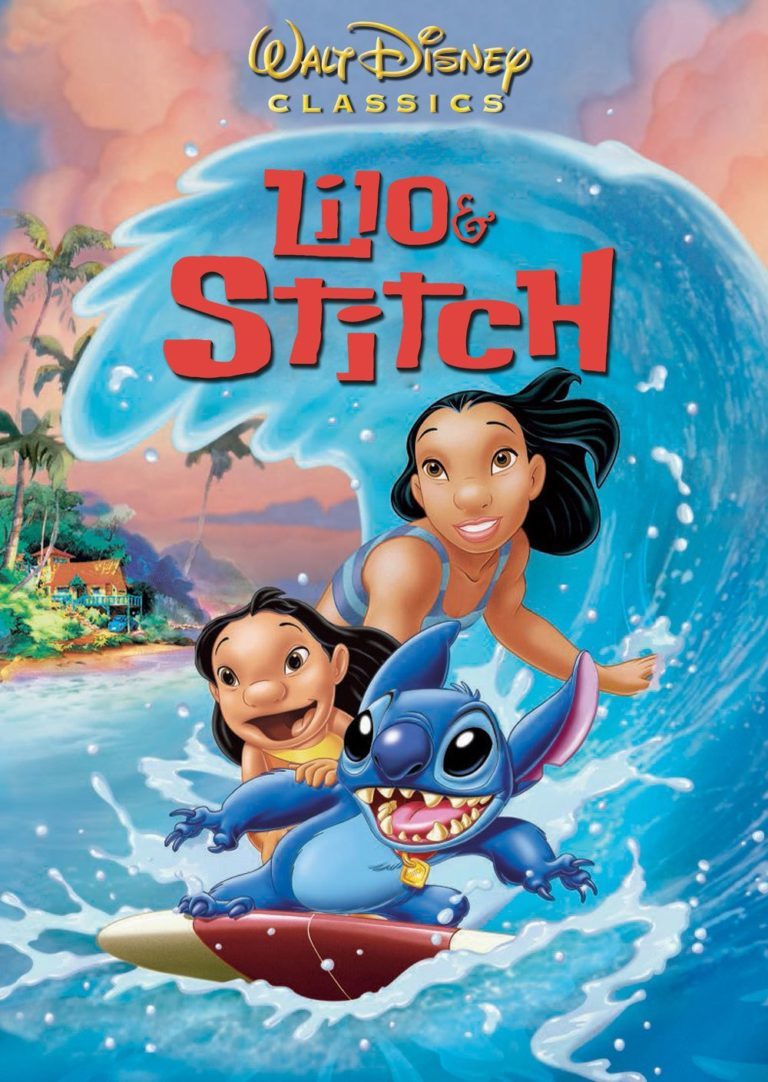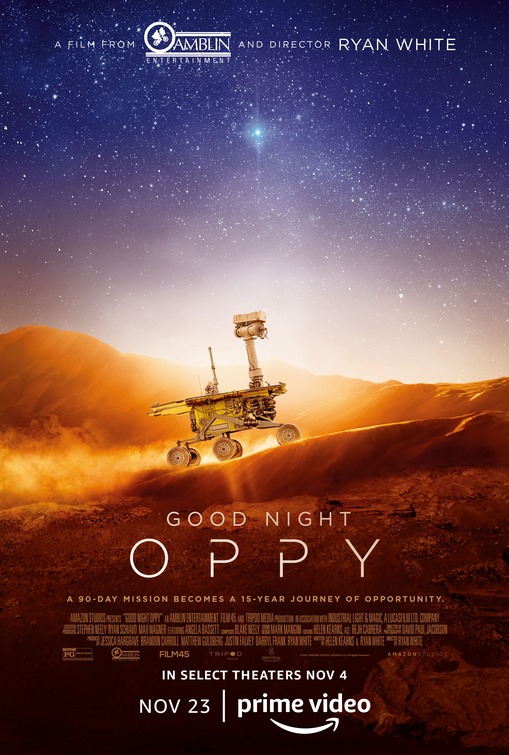“Celebrating Spirit, Opportunity, Teamwork, and Family”

| None | Light | Moderate | Heavy | |
|---|---|---|---|---|
| Language | ||||
| Violence | ||||
| Sex | ||||
| Nudity |
What You Need To Know:
For 105 minutes, the viewers are enthralled by the stories that GOOD NIGHT OPPY tells about the people in the halls of the Jet Propulsion Lab and about the two sets of wheels turning upon the very dusty red environs of Mars. Masterful editing of newsreel footage, engaging interviews with the ground crew of mission control, and life-like animation of the rovers on Mars all work together to tell those inspiring, enthralling, real-life stories. GOOD NIGHT OPPY is very family friendly. It has a strong moral worldview promoting the search for truth, with a great example of teamwork and direct references and indirect allusions to parenthood and love.
Content:
Strong moral worldview, about two robot rovers on Mars, promotes the search for truth (using science), with great examples of teamwork, cooperation, camaraderie, and transparency, plus direct, positive references and indirect positive allusions to parenthood and love (e.g., one woman relates her pregnancy of twin babies to the twin root rovers exploring Mars)
At least one “d” obscenity toward the end of the movie in an assessment of how hard the rover robots worked
No violence
No sex
No nudity
One very brief scene shows a large group engaging in a champagne toast
No smoking or drugs;
Nothing else objectionable or potentially objectionable.
More Detail:
If this NASA effort, officially titled the Mars Exploration Rover mission (MER), had merely fulfilled its goal of 90 days of data collection from the fourth planet from the sun, the whole thing would have been considered rousingly successful. Yet the Spirit (MER-A) rover ran for just over 6 years, and the Opportunity (MER-B) ran for an astounding 15 years, outlasting a number of the human careers that oversaw the mission from the Jet Propulsion Laboratory (JPL) in Pasadena, California. JPL is the other sustained location of GOOD NIGHT OPPY. For nearly two hours, the viewer’s mind and heart are enthralled by both the people at the desks and in the labs of JPL and the two sets of wheels turning upon the very dusty red environs of Mars.
The art and skills of storytelling make or break any movie, and documentaries are especially needful of masterful crafting of a few routine ingredients to hold a viewer’s imagination. Here, GOOD NIGHT OPPY succeeds brilliantly. First, there is contemporary imagery of the subject covered; in GOOD NIGHT OPPY’s case, there are photos and newsreel footage covering everything from early conceptual days through the end of mission. NASA provided the documentary filmmakers almost 1,000 hours of footage.
Another staple ingredient set uses up-to-date interviews of participants and pundits, years after the fact, to reflect upon what happened and to point out what has turned out to be the most significant over time. Though there’s no doubt the filmmakers had enough material to make a mini-series covering the nearly quarter of a century of memories, highlights and reflections from the ground crew of mission control of the Mars Exploration Rover venture, GOOD NIGHT OPPY makes for an insightful, inspiring 98-minute highlight movie that leaves the viewer wanting more of JPL’s contagious sense of adventure and emotional sense of purpose.
Few documentaries get away with not recreating a crime scene, a battle or personal drama using actors and sets to re-enact the subject at hand. GOOD NIGHT OPPY is no exception, and in fact, this ingredient may be the most significant in this recipe, guaranteeing its fame and success. Put simply, the scenes on Mars (especially of the rovers roving over red dust, rocks, crater rims, and toward sunrises) all give viewers an incredible sense of being there. And yet, it’s animation. Not cartoon animation, mind you. It’s actually some of the most complex animation come to filmmaking yet. Leave it to Industrial Light & Magic (ILM, the creators of fictional planetary worlds in classics like STAR WARS and the STAR TREK movies) to accomplish the feat. Director Ryan White explains:
“We had hundreds of thousands of eye-level photographs of the real Mars from the rovers, but also high-res satellite images that gave us detail about the topography. . . which meant we couldn’t just throw a crater here or some mountains there. ILM forensically used the images and the data to transport the audience to an authentic Mars terrain, the same spaces that Opportunity and Spirit were actually going through.”
Taking it one giant leap further, Industrial Light & Magic animated both Spirit and Opportunity to be driving through, getting stuck in, and performing robotic body movements upon this exacting terrain. When all is said and done, it’s the life-like animation of the rovers on Mars ingeniously accomplished by Industrial Light & Magic that lets the movie tell an inspiring and enthralling, real-life story.
One more ingredient intentionally rippling through the entire work of GOOD NIGHT OPPY is the emotional component of human relationships with the robots. For instance, at the movie’s outset, while showing newsreel footage of early development and testing of the robots, the mission’s Principal Scientist narrates the “deliberate decision to make the robot human-like. . . five foot two” and eyes of true “20-20 vision” through the two cameras mounted on their heads. Later, after Spirit’s rough and tumble landing, and after an uncomfortable delay of expected communication, a mission leader proclaims, “My child has arrived!” This was one of many references and allusions to the robots as the team’s family that they had birthed. Sadly, toward the end of each mission, Spirit and Opportunity were described as getting arthritis as the red Mars dust began to cripple their wheels and arm joints, or as developing dementia, when their computer memory began to be completely lost every morning upon routine wake-ups, causing Mission Control to cope with the “amnesia” by downloading the rovers’ memory every night before bedtime to ensure critical data retention on a daily basis.
Finally, looking back upon the entire experience, one participant admits, “We loved these rovers.” Another one says, “As a parent, I’m proud. As a human noted, I’m sad. She was a friend.” Finally, with the 2020 launch of another Mars mission rover, named Perseverance, a scientist says, “Perseverance will be their grandchild.”
GOOD NIGHT OPPY has a strong moral worldview. It promotes the search for truth, using science, not to mention logic and reason. It also has great examples of teamwork, cooperation, camaraderie, and transparency. Finally, there are direct positive references and indirect positive allusions to parenthood and love. The Mission Control team expresses much love, caring and nurturing toward their robotic creations. Though these are mechanical, inanimate objects, they are made by humans, so they reflect that humanity.
GOOD NIGHT OPPY has no violence, sex, nudity, or substance abuse. However, a “d” word obscenity is used when someone says how hard the robots worked.
All in all, GOOD NIGHT OPPY is extremely family friendly. For a real five-year-old’s actual reaction, as well as those from both the movie director and a mission project scientist, see the video interview of the movie that MOVIEGUIDE’s own Evy Baehr Carroll does at https://www.facebook.com/movieguide/videos/1072745226632711. GOOD NIGHT OPPY will encourage viewers to go looking for more information about this Mars rover mission as well as what’s happening with plans that MASA has for its Mars program.
GOOD NIGHT OPPY had a limited release in theaters and is now available to stream on Amazon Prime.


 - Content:
- Content: 

